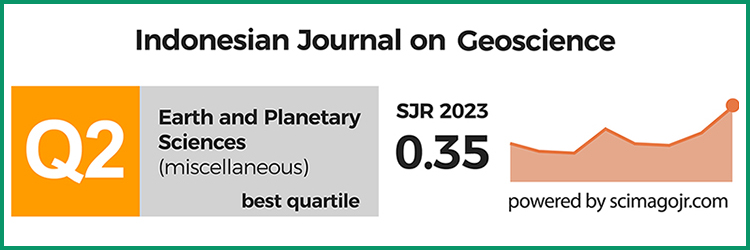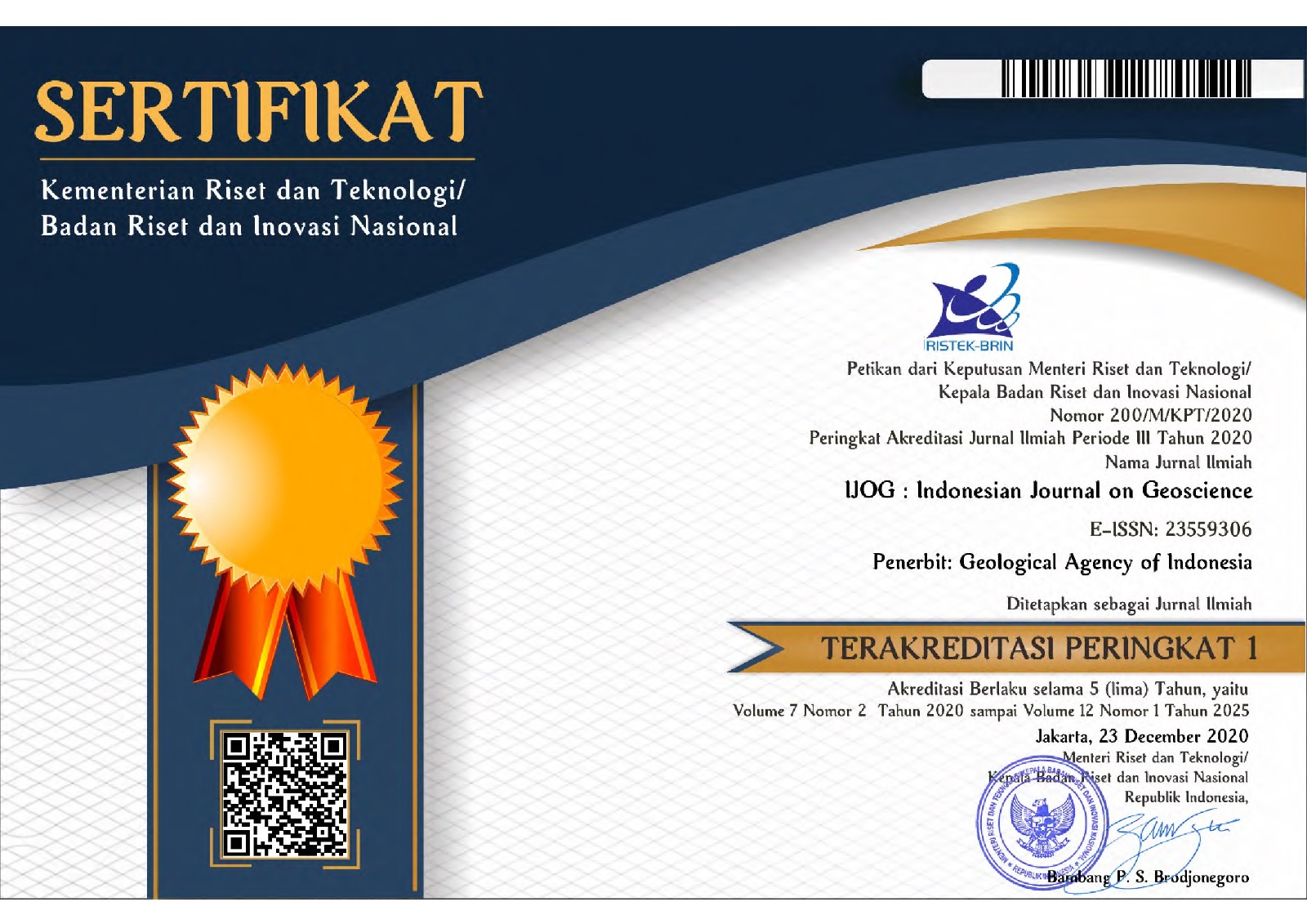Terrestrial Laser Scanner (TLS) Measurement in A Volcanic Area: Detection of Error Source and Scanned Object Intensity
DOI:
https://doi.org/10.17014/ijog.7.2.179-200Keywords:
laser scanner, gas emission, correction model, intensityAbstract
DOI:10.17014/ijog.7.2.179-200
The purpose of the study of Terrestrial Laser Scanner (TLS) application in an active volcanic crater is to detect the influence of gas emission and local atmospheric change into the accuracy of measurement.The measurement was conducted at Papandayan Volcano crater, along with the local temperature, humidity, and air pressure (thp). The measured target located near a gas emission hole gives a significant fluctuative range due to possible false return by gas particles. The refraction index was calculated using thp data. Two correction models were applied: velocity-geometry and atmospheric delay correction. The atmospheric delay correction gives a more reliable result, however their refraction index calculation does not accomodate specific volcanic gas yet. An intensity map obtained from TLS can also be used for rock segmentation. An experiment from some types of volcanic rocks shows that the intensity value is influenced by a weathering degree of rock outcrops. Rock segmentation using TLS intensity data for fresh outcrops is relatively easier, while for weathered rocks it still needs a field check for validation. The temperature of volcanic rocks also contributes to the intensity value. It is found that the intensity increases along with the temperature of rock.
References
Abshire, B., James and Gardner, S. Chester, (1985): Atmospheric refractivity corrections in satellite laser ranging. IEEE transactions on geoscience and remote sensing, GE-23, (4), July 1985. DOI:10.1109/TGRS.1985.289431
Barrell, H. and Sears, J.E., 1939. The refraction dispersion of air for visible spectrum. Philosophical Transactions of the Royal Society A: Mathematical, Physical and Engineering Sciences, 238, p.1-64.
Birch, K. P., dan Downs, M. J. (1994): Correction to the updated Edlen equation for the refractive index of air. Metrologia, 31, 315-316. DOI:10.1088/0026-1394/31/4/006
Boehler, W., dan Marbs, A. (2006): Investigating Laser Scanner Accuracy, Institute for Spatial Information and Surveying Technology, University of Applied Sciences, Mainz, Germany.
Bonforte, A., Calvagn, F., Puglisi, G, dan Sacareno, B. (2011): Terrestrial Laser Scanning (TLS) Over Volcanic Areas : Experiments on Vesuvius, Stromboli and Vulcano (Italy), Geophysical Research abstracts, Vol. 13, EGU2011-11657,2011, EGU General Assembly 2011.
Ciddor, E.P., 1996. Refractive index of air: new equations for the visible and near infrared. Applied Optics, 35 (9), p.1566-1573. DOI:10.1364/AO.35.001566
Ciddor, P.E, dan Hill, R.J (1999): Refractive index of air, 2 group index. Appl.Opt., 38, 1663-1667. DOI:10.1364/AO.38.001663
Davis, J.L., Herrig, T.A, Shapiro I.I, Rogers, A.E.E., and Elgered, G., 1985. Geodesy by radio interferometry; effects of atmospheric modelling errors on estimates of baseline length. Radio Science, 20 (6), p.1593-1607. DOI:10.1029/RS020i006p01593
Edlen, B. (1996): the refractive index of air. Metrologia, 2, 71-80.
Erickson, K.E. (1962): Investigation of the invariance of atmospheric dispersion with a long-path interferometer. J.Opt.Soc.Am., 52, 777-780.
Granthamn, J.W., Stargardt, C.D., Dungey, C., dan Meidunas, E. (1997): Laser Radar in adverse weather, SPIE proceedings, Vol. 3065, pp 84-93.
Haerani, N., 2016.Analisis dan pemodelan pengaruh lingkungan gunung api terhadap hasil pengukuran pemindai laser terestris (TLS). Disertasi.Program Doktor Teknik Geodesi dan Geomatika, Institut Teknologi Bandung.
Hauser, J.P (1991): Effects of deviations from hydrostatic equilibrium on atmospheric corrections to satellite and lunar laser range measurements, Journal of Geophysical Research, 94 (B8), p.10182-10186. DOI:10.1029/JB094iB08p10182
Hofle, B., dan Pfeifer, N. (2007): Correction of laser scanning intensity data: data and model-driven approaches. ISPRS Journal of Photogrammetry and Remote Sensing 62, p. 415-433. DOI:10.1016/j.isprsjprs.2007.05.008
Hou, W., dan Thalmann R. (1994): Accurate measurement of the refractive index of air. Measurement 13, 307-314. DOI:10.1016/0263-2241(94)90055-8
Hulley, G.C., 2007. Imroved refraction correction for satellite ranging (SLR) by ray tracing through meteorological data. Thesis (PhD), Faculty of Graduate School, University of Maryland, Baltimore, 160pp. Shaker Verlag Aachen.
Hunter, G., Pinkerton, H., Airey R. dan Calvari, S. (2003): The Application of A Long-range Laser Scanner for Monitoring Volcanic Activity on Mount Etna, Journal of Volcanology and Geothermal research, 123 (1-2), 203-210. DOI:10.1016/S0377-0273(03)00036-2
Ingensand, H., 2006. Metrological Aspect in Terrestrial Laser Scanning Technology, Institute of Geodesy and Photogrammetry, ETH Zurich. 3rd IAG/12th FIG Symposium, Baden.
Jones, L.D., 2007.The Application of Terrestrial LIDAR to Volcano Monitoring - An Example from The Montserrat Volcano Observatory. British Geological Surveys, Keyworth, Nottingham.
Jones, L.K., Kyle, P.R., Oppenheimer, O., and Frechette, J.D., 2015. TLS observations of geomorphic changes and varying lava lake levels at Erebus Volcano, Antartica. Journal Volcanology and Geothermal Research, 295, p.43-54. DOI:10.1016/j.jvolgeores.2015.02.011
Jutzi B. and Stilla U.,2003. Laser pulse analysis for reconstruction and classification of urban objects. ISPRS Archives, XXXIV (3/w8), Munich.
Kaasalainen, S., Vain, A., Krooks, A., and Kukko., A., 2010. Topographic and distance effects in laser scanner intensity correction. Finnish Geodetic Institute, Department of Remote Sensing and Photogrammetry.In: Bretar, F., Pierrot-Deseilligny, M. and Vosselman, G. (eds.), Laser scanning, IAPRS, XXXVIII (3/W8).
Kaasalainen, S., Jaakkola, A., Kaasalainen, M., Krooks, A., and Kukko, A., 2011. Analysis of incidence angle and distance effects on terrestrial laser scanner intensity: search for correction methods. Remote Sensing, 3, p.2207-2221. DOI:10.3390/rs3102207
Litchi, D.D. and Harvey, B.R., 2002. The effects of reflecting surface material properties on time-of-flight laser scanner measurements. Symposium on Geospatial Theory, Processing, and Applications, Ottawa, Canada.
Lichti, D.D.and Licht, M.G., 2006. Experiences with TLS modelling and accuracy assesment. IAPRS, XXXVI (5), Dresden 25 - 27 September 2006.
Maata, K., Kostamovaara, J., and Myllyla, R., 1993. Profiling of hot surfaces by pulsed timeof-flight laser rangefinder techniques. Applied Optics, 32 (27), p.5324-5347. DOI:10.1364/AO.32.005334
Marini, J.W., 1972. Correction of satellite tracking data for an arbitrary tropospheric profile. Radio Science, 7, p.223-231.
Marini, J.W. and Murray, C.W., 1973. Correction of laser range tracking data for atmospheric refraction at elevations above 10 degrees. NASA Report, X-501-73-351.
Mendes, V.B. and Pavlis, E.C., 2004.High accuracy zenith delay prediction at optical wavelengths. Geophysical Research Letter, 31(L14602). DOI:10.1029/2004GL020308
Mettenleiter, M., Hartl, F., Frolich, C., and Langer, D., 2000.Imaging Laser Radar for 3D-Modelling of Real World Environments. Proceedings of International Conference on OPTO/IRS2/MTT, May 9 - 11, Germany.
Owens, J.C., 1967. Optical refractive index of air; dependence on pressure, temperature and composition. Applied Optics, 6, p.51-59.
Peck, E.R. and Reeder, K., 1972.Dispersion of air. Journal Optics Society of America, 62, p.958-962. DOI: 10.1364/AO.6.000051
Pesci, A., Teza, G., and Ventura, G., 2008. Remote Sensing of Volcanic Terrains by Terrestrial Laser Scanner: Preliminary Reflectance and RGB Implications for Studying Vesuvius Crater (Italy). Annals of Geophysics, 51 (4), p.633-653. DOI:10.4401/ag-4455
Pfeifer, N., Dorninger, P., Haring, A., and Fan, H., 2007.Investigating Terrestrial Laser Scanning intensity data: quality and functional relations. 8th Conference On Optical 3-D Measurement Techniques, p.328-337, Zurich, Switzerland.
Pfeifer, N., Hofle, B., Briese, C., Rutzinger, M., and Haring, A., 2008.Analysis of the backscattered energy in Terrestrial Laser Scanning data. The International Archives of the Photogrammetry. Remote Sensing and Spatial Information Sciences, XXXVII (B5), Beijing.
Quintero, M.S., Genechten, B.V., Bruyne, M.D., Ronald, P., Hankar, M., and Barnes, S., 2008. Theory and Practice on Terrestrial Laser Scanning, Training Material Based on Practical Applications, Vlaams Leonardo da Vinci Agenschap.
Reshetyuk, Y., 2006. Investigation of the influence of surface reflectance on the measurements with the terrestrial laser scanner Leica HDS 3000. Zeitschrift für Geodäsie, Geoinformation und Landmanagement 2006 (2), 96-103.
Reshetyuk, Y., 2009. Terrestrial laser scanning error sources, s elf-calibration and direct georeferencing. VDMVerlag Dr. Muller, Germany.
Rueger, J.M.,1990.Electronic distance measurement. An Introduction, 3rd totally revised ed., Springer Verlag, Berlin.
Saastamonen, J., 1973.Contributions to the theory of atmospheric refraction, in three parts.Bulletin Geodesique, 105, p.279-298.
Staiger, R., 2003.Terrestrial laser scanning technology, systems and applications. 2nd FIG Regional Conference, Marrakesh, Morocco, December 2 - 5.
Tsakiri, M., Lichti, D.and Pfeifer, N., 2006. ‘Terrestrial laser scanning for deformation monitoring’.12th FIG Symposium. https://www.fig.net/resources/proceedings/2006/baden_2006_comm6/PDF/LS2/Tsakiri.pdf
Vidyan, Y., Abidin, H.Z , Gumilar, I., and Haerani, N., 2013. Pemanfaatan metode TLS (Terrestrial Laser Scanning) untuk pemantauan deformasi gunung api. Studi kasus: kerucut sinder Gunung Galunggung, Jawa Barat. Jurnal Lingkungan dan Bencana Geologi, 4 (1),p. 49-69.
Voegtle, T., Schwab, I., and Landes, T., 2008. Influences of different materials on the measurements of a Terrestrial Laser Scanner (TLS). The International Archives of the Photogrammetry, Remote Sensing and Spatial Information Sciences, XXXVII (B5), Beijing, China.
Waggott, S., Clegg, P., and Jones, R., 2005. Combining Terrestrial Laser Scanning, RTK, GPS, and 3D Visualisation: Application of Optical 3D Measurement in Geological Exploration. 7th Conference on Optical 3-D Measurement Techniques. Vienna, Austria. https://info.tuwien.ac.at/ingeo/optical3d/o3d.htm
Wallace, J.M. and Hobbs, P.V., 2006. Atmospheric Science; An Introductory Survey (2nd ed.). Academic Press.
Wijaya, D.D., 2010. Atmospheric Correction Formulae for Space Geodetic Techniques. Shaker Verlag Aachen.



















